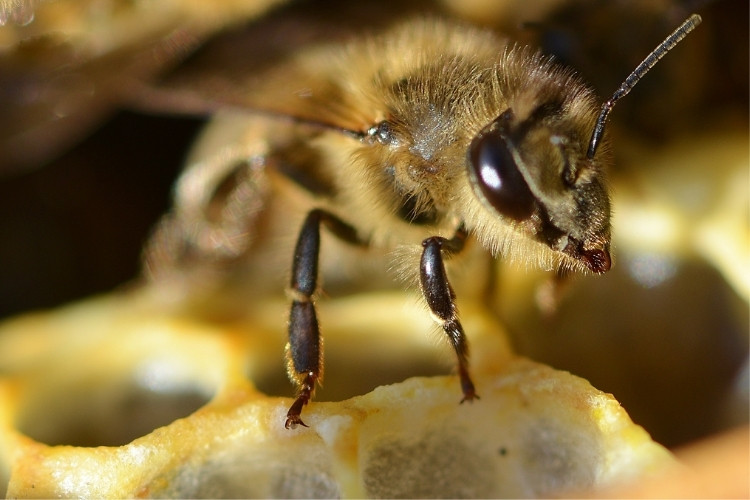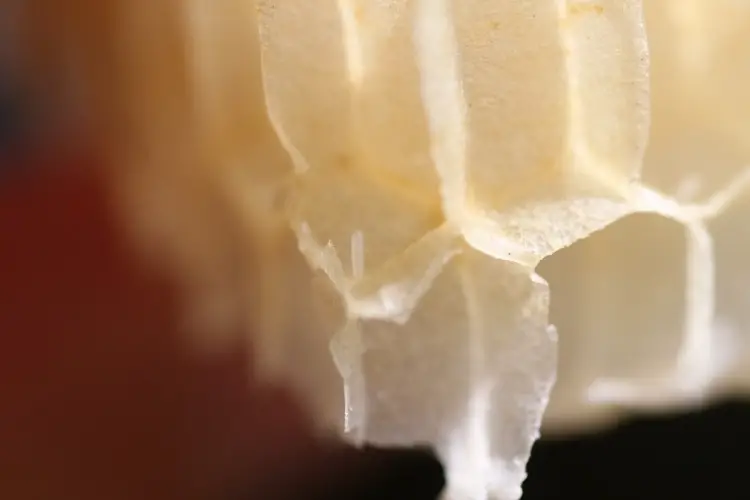Beeswax is one of the most popular bee products used by humans. It is a compound secreted by four pairs of special glands located on the inner side of a bee’s abdomen.
Honey is the primary raw material used to make wax. It all starts when bees eat honey and metabolize its sugars.
Beeswax is initially secreted in the shape of scales which bees transport to their mandibles and chew before using them on the comb. When they chew the wax scales, they add other secretions which transform the initial wax into the material bees use to build their combs.
Beeswax is another example of the precise division of labor found inside a colony, because not all bees participate in the production of wax and comb construction. Only worker bees produce wax because the queen and drones don’t have wax glands.

Wax glands take between 9 and 12 days to develop, and they start degenerating after around 18 to 21 days. Therefore, this task is usually done by worker bees in this age range.
Fun fact: A worker bee can secrete up to half her body weight in wax during her lifetime!
What Do Bees Use Wax For
Wax takes several key roles inside a beehive. The most popular one is as construction material for comb.
Many beekeepers would agree that drawn comb becomes an essential resource in taking care of bees. This structure provides bees space to store food resources like nectar, honey, and pollen and the place for the queen to lay eggs and allow the brood to develop. However, there are many other essential functions of beeswax for a bee colony.
For example, beeswax plays a crucial role in the chemical communication of the colony, including the cues that allow them to recognize other nestmates.
When bees emerge as young workers, they don’t have the distinct signals that allow them to be recognized as part of the colony. They acquire these recognition cues as they come into direct contact with the wax comb, and the odors integrate into their cuticles.
The comb also becomes the medium through which pheromones can get distributed throughout the colony, allowing the regulation of most behaviors in the colony. An example of this is the inhibition of queen cell construction before swarming.
Research showed that when colonies grow and become crowded, swarm cells are constructed on the bottom edges of the comb – a place where the queen doesn’t go much and is rarely marked with her pheromones which inhibit the construction of queen cells.
To prove this, researchers spread a combination of pheromones around the bottom edges of the comb, resulting in bees not making swarm cells there.
The wax comb doesn’t just facilitate chemical communication – the messages bees send each other through sound and other vibrations also involve the interaction with the comb. For example, the comb transmits vibrational signals from bees performing the waggle dance to recruit other foragers.
What Is Beeswax Made Of?
The chemical composition of beeswax is quite complex, containing more than 300 compounds. However, fatty acid esters represent 67% of the composition, followed by hydrocarbons with 14%.
Contaminants Found In Beeswax
Given the broad uses of beeswax, the contamination of this product has been studied to make sure its use in industries like cosmetics doesn’t represent a health risk.
Even though contaminants can have an environmental source like air and water, research points to insecticides as the most significant source of contamination of products like wax.
Varroacides, in particular, leave significant residue in beeswax, which takes a long time to disintegrate because they are usually used for long-term control of varroa mite.
However, alternative treatments, like organic acids and essential oils don’t leave residue in wax and seem to be effective.
What Does Beeswax Look Like?
Freshly secreted beeswax is white; however, over time, it turns yellow as it comes into contact with propolis and pollen.

The process of brood rearing also has a significant effect on the color of the comb. This is because before bee larvae become pupae, they cover their cell walls with thin sheets of silk.
The larvae also produce other materials that are applied to the silk base and can have a yellowish tone.
Once a pupa becomes a fully developed adult bee, it leaves the cell, and other worker bees clean it before another egg is laid inside. However, the silk is not removed.
Eventually, after a few bees have been raised in the cell, the silk cocoons accumulate, reducing the space inside the cell and turning the comb darker.
Human Uses Of Beeswax
Human use of beeswax can be traced as far back as ancient Egypt, when people used the material in the embalming and mummification process of pharaohs.
Wax is hydrophobic, which means it repels water. For this reason, it has been used throughout history to preserve materials like papyrus and paintings.
Recently, eating the whole honeycomb, has been a popular way to include beeswax into cooking.
Pharmaceutical And Medical Use Of Beeswax
Beeswax has also been a popular product in traditional medicinal practices.
For instance, the Egyptians used beeswax to treat burns, wounds, and joint pain.
In Chinese traditional medicine, beeswax was recognized for its ability to balance the body, influencing blood and energy systems, besides its cosmetic and anti-aging properties.
And it seems like ancient civilizations were on to something given beeswax is still studied and used in the pharmaceutical and medical fields. For example, beeswax helps retain moisture in the skin, including the lips. Therefore it’s a common ingredient in lipsticks and ointments.
Beeswax is considered safe to eat and doesn’t interact with the digestive system, increasing the interest of researchers in the use of beeswax in the encapsulation of medications.
Other studies have shown positive results when some dermatological conditions like diaper dermatitis, atopic dermatitis, and psoriasis are treated by mixing beeswax with other substances.
Summing Up… How Do Bees Make Wax?
Bees metabolize the sugars in honey and produce wax through their wax glands, located on the bottom of their abdomen.
Beeswax has an essential role in the beehive. It provides the building material for the honeycomb, where honey, nectar, and pollen are stored, and the queen lays the eggs.
Additionally, the comb’s wax helps bees recognize their nestmates through chemical signals and facilitates communication in the colony.
Beeswax has a complex composition with fatty acid esters, and hydrocarbons make it up most of it.
Until today, beeswax has been used in a broad range of industries. As such, there is an interest in the research of substances that can contaminate this product.
